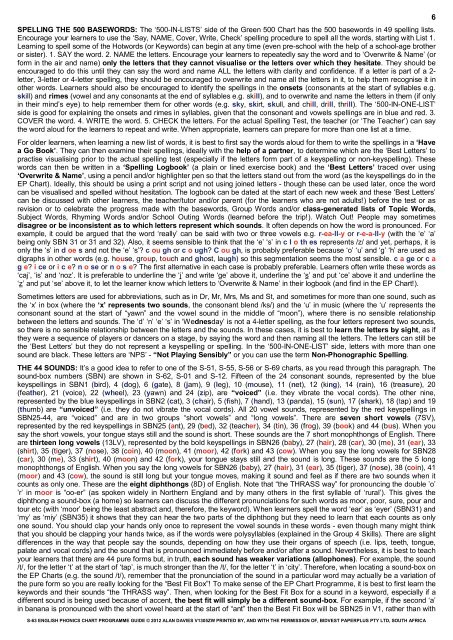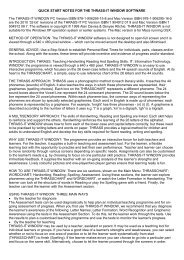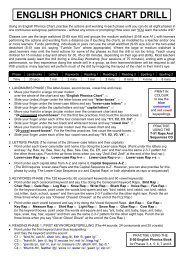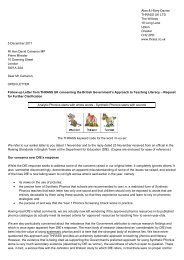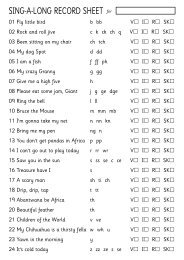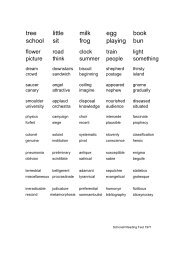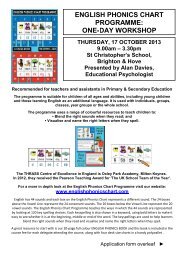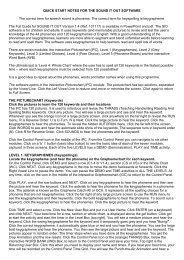English Phonics Chart Programme Guide - THRASS
English Phonics Chart Programme Guide - THRASS
English Phonics Chart Programme Guide - THRASS
Create successful ePaper yourself
Turn your PDF publications into a flip-book with our unique Google optimized e-Paper software.
SPELLING THE 500 BASEWORDS: The ‘500-IN-LISTS’ side of the Green 500 <strong>Chart</strong> has the 500 basewords in 49 spelling lists.<br />
Encourage your learners to use the ‘Say, NAME, Cover, Write, Check’ spelling procedure to spell all the words, starting with List 1.<br />
Learning to spell some of the Hotwords (or Keywords) can begin at any time (even pre-school with the help of a school-age brother<br />
or sister). 1. SAY the word. 2. NAME the letters. Encourage your learners to repeatedly say the word and to ‘Overwrite & Name’ (or<br />
form in the air and name) only the letters that they cannot visualise or the letters over which they hesitate. They should be<br />
encouraged to do this until they can say the word and name ALL the letters with clarity and confidence. If a letter is part of a 2-<br />
letter, 3-letter or 4-letter spelling, they should be encouraged to overwrite and name all the letters in it, to help them recognise it in<br />
other words. Learners should also be encouraged to identify the spellings in the onsets (consonants at the start of syllables e.g.<br />
skill) and rimes (vowel and any consonants at the end of syllables e.g. skill), and to overwrite and name the letters in them (if only<br />
in their mind’s eye) to help remember them for other words (e.g. sky, skirt, skull, and chill, drill, thrill). The ‘500-IN-ONE-LIST’<br />
side is good for explaining the onsets and rimes in syllables, given that the consonant and vowels spellings are in blue and red. 3.<br />
COVER the word. 4. WRITE the word. 5. CHECK the letters. For the actual Spelling Test, the teacher (or ‘The Teacher’) can say<br />
the word aloud for the learners to repeat and write. When appropriate, learners can prepare for more than one list at a time.<br />
For older learners, when learning a new list of words, it is best to first say the words aloud for them to write the spellings in a ‘Have<br />
a Go Book’. They can then examine their spellings, ideally with the help of a partner, to determine which are the ‘Best Letters’ to<br />
practise visualising prior to the actual spelling test (especially if the letters form part of a keyspelling or non-keyspelling). These<br />
words can then be written in a ‘Spelling Logbook’ (a plain or lined exercise book) and the ‘Best Letters’ traced over using<br />
‘Overwrite & Name’, using a pencil and/or highlighter pen so that the letters stand out from the word (as the keyspellings do in the<br />
EP <strong>Chart</strong>). Ideally, this should be using a print script and not using joined letters - though these can be used later, once the word<br />
can be visualised and spelled without hesitation. The logbook can be dated at the start of each new week and these ‘Best Letters’<br />
can be discussed with other learners, the teacher/tutor and/or parent (for the learners who are not adults!) before the test or as<br />
revision or to celebrate the progress made with the basewords, Group Words and/or class-generated lists of Topic Words,<br />
Subject Words, Rhyming Words and/or School Outing Words (learned before the trip!). Watch Out! People may sometimes<br />
disagree or be inconsistent as to which letters represent which sounds. It often depends on how the word is pronounced. For<br />
example, it could be argued that the word ‘really’ can be said with two or three vowels e.g. r-ea-ll-y or r-e-a-ll-y (with the ‘e’ ‘a’<br />
being only SBN 31 or 31 and 32). Also, it seems sensible to think that the ‘e’ ‘s’ in c l o th es represents /z/ and yet, perhaps, it is<br />
only the ‘s’ in d oe s and not the ‘e’ ‘s’? c ou gh or c o ugh? C ou gh, is probably preferable because ‘o’ ‘u’ and ‘g’ ‘h’ are used as<br />
digraphs in other words (e.g. house, group, touch and ghost, laugh) so this segmentation seems the most sensible. c a ge or c a<br />
g e? i ce or i c e? n o se or n o s e? The first alternative in each case is probably preferable. Learners often write these words as<br />
‘caj’, ‘is’ and ‘noz’. It is preferable to underline the ‘j’ and write ‘ge’ above it, underline the ‘s’ and put ‘ce’ above it and underline the<br />
‘z’ and put ‘se’ above it, to let the learner know which letters to ‘Overwrite & Name’ in their logbook (and find in the EP <strong>Chart</strong>!).<br />
Sometimes letters are used for abbreviations, such as in Dr, Mr, Mrs, Ms and St, and sometimes for more than one sound, such as<br />
the ‘x’ in box (where the ‘x’ represents two sounds, the consonant blend /ks/) and the ‘u’ in music (where the ‘u’ represents the<br />
consonant sound at the start of “yawn” and the vowel sound in the middle of “moon”), where there is no sensible relationship<br />
between the letters and sounds. The ‘d’ ‘n’ ‘e’ ‘s’ in ‘Wednesday’ is not a 4-letter spelling, as the four letters represent two sounds,<br />
so there is no sensible relationship between the letters and the sounds. In these cases, it is best to learn the letters by sight, as if<br />
they were a sequence of players or dancers on a stage, by saying the word and then naming all the letters. The letters can still be<br />
the ‘Best Letters’ but they do not represent a keyspelling or spelling. In the ‘500-IN-ONE-LIST’ side, letters with more than one<br />
sound are black. These letters are ‘NPS’ - “Not Playing Sensibly” or you can use the term Non-Phonographic Spelling.<br />
THE 44 SOUNDS: It’s a good idea to refer to one of the S-51, S-55, S-56 or S-69 charts, as you read through this paragraph. The<br />
sound-box numbers (SBN) are shown in S-62, S-01 and S-12. Fifteen of the 24 consonant sounds, represented by the blue<br />
keyspellings in SBN1 (bird), 4 (dog), 6 (gate), 8 (jam), 9 (leg), 10 (mouse), 11 (net), 12 (king), 14 (rain), 16 (treasure), 20<br />
(feather), 21 (voice), 22 (wheel), 23 (yawn) and 24 (zip), are “voiced” (i.e. they vibrate the vocal cords). The other nine,<br />
represented by the blue keyspellings in SBN2 (cat), 3 (chair), 5 (fish), 7 (hand), 13 (panda), 15 (sun), 17 (shark), 18 (tap) and 19<br />
(thumb) are “unvoiced” (i.e. they do not vibrate the vocal cords). All 20 vowel sounds, represented by the red keyspellings in<br />
SBN25-44, are “voiced” and are in two groups “short vowels” and “long vowels”. There are seven short vowels (7SV),<br />
represented by the red keyspellings in SBN25 (ant), 29 (bed), 32 (teacher), 34 (tin), 36 (frog), 39 (book) and 44 (bus). When you<br />
say the short vowels, your tongue stays still and the sound is short. These sounds are the 7 short monophthongs of <strong>English</strong>. There<br />
are thirteen long vowels (13LV), represented by the bold keyspellings in SBN26 (baby), 27 (hair), 28 (car), 30 (me), 31 (ear), 33<br />
(shirt), 35 (tiger), 37 (nose), 38 (coin), 40 (moon), 41 (moor), 42 (fork) and 43 (cow). When you say the long vowels for SBN28<br />
(car), 30 (me), 33 (shirt), 40 (moon) and 42 (fork), your tongue stays still and the sound is long. These sounds are the 5 long<br />
monophthongs of <strong>English</strong>. When you say the long vowels for SBN26 (baby), 27 (hair), 31 (ear), 35 (tiger), 37 (nose), 38 (coin), 41<br />
(moor) and 43 (cow), the sound is still long but your tongue moves, making it sound and feel as if there are two sounds when it<br />
counts as only one. These are the eight diphthongs (8D) of <strong>English</strong>. Note that “the <strong>THRASS</strong> way” for pronouncing the double ’o’<br />
’r’ in moor is “oo-er” (as spoken widely in Northern England and by many others in the first syllable of ‘rural’). This gives the<br />
diphthong a sound-box (a home) so learners can discuss the different pronunciations for such words as moor, poor, sure, pour and<br />
tour etc (with ‘moor’ being the least abstract and, therefore, the keyword). When learners spell the word ‘ear’ as ‘eyer’ (SBN31) and<br />
‘my’ as ‘miy’ (SBN35) it shows that they can hear the two parts of the diphthong but they need to learn that each counts as only<br />
one sound. You should clap your hands only once to represent the vowel sounds in these words - even though many might think<br />
that you should be clapping your hands twice, as if the words were polysyllables (explained in the Group 4 Skills). There are slight<br />
differences in the way that people say the sounds, depending on how they use their organs of speech (i.e. lips, teeth, tongue,<br />
palate and vocal cords) and the sound that is pronounced immediately before and/or after a sound. Nevertheless, it is best to teach<br />
your learners that there are 44 pure forms but, in truth, each sound has weaker variations (allophones). For example, the sound<br />
/t/, for the letter ‘t’ at the start of ‘tap’, is much stronger than the /t/, for the letter ‘t’ in ‘city’. Therefore, when locating a sound-box on<br />
the EP <strong>Chart</strong>s (e.g. the sound /t/), remember that the pronunciation of the sound in a particular word may actually be a variation of<br />
the pure form so you are really looking for the “Best Fit Box”! To make sense of the EP <strong>Chart</strong> <strong>Programme</strong>, it is best to first learn the<br />
keywords and their sounds “the <strong>THRASS</strong> way”. Then, when looking for the Best Fit Box for a sound in a keyword, especially if a<br />
different sound is being used because of accent, the best fit will simply be a different sound-box. For example, if the second ‘a’<br />
in banana is pronounced with the short vowel heard at the start of “ant” then the Best Fit Box will be SBN25 in V1, rather than with<br />
S-63 ENGLISH PHONICS CHART PROGRAMME GUIDE © 2012 ALAN DAVIES V1305ZW PRINTED BY, AND WITH THE PERMISSION OF, BIDVEST PAPERPLUS PTY LTD, SOUTH AFRICA<br />
6


